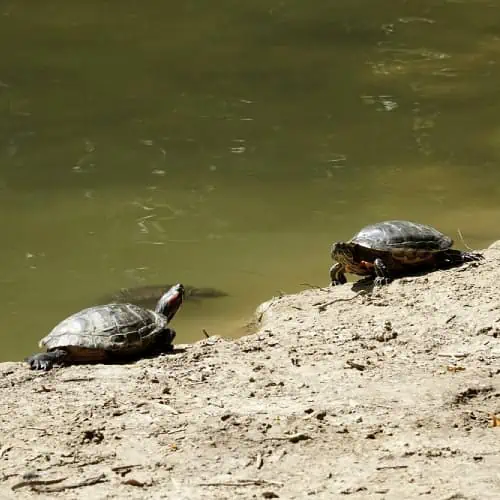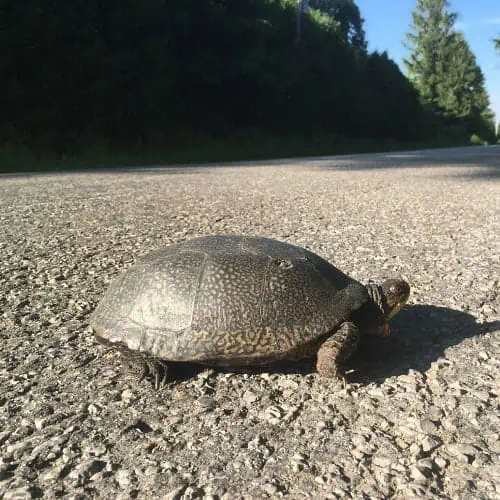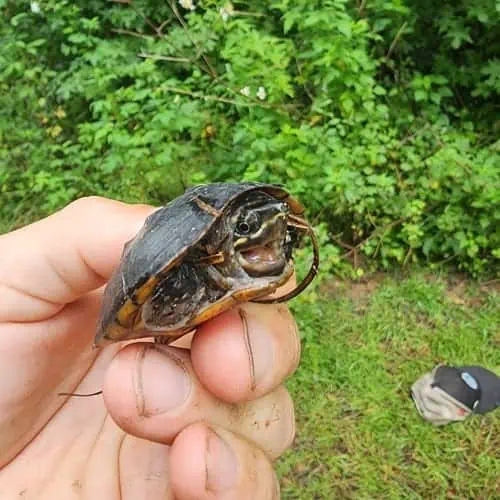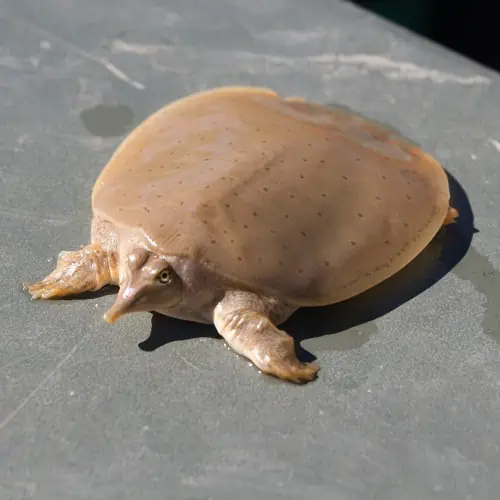
Ohio is located in the northeastern part of the United States just below Lake Erie. While much of the state has been converted into farmland by humans, a substantial portion remains in good condition and supports many wildlife species. Most important for turtles are wetlands and other aquatic habitats, of which Ohio has plenty. These habitats support a diverse array of organisms.
Many of Ohio’s aquatic habitats were sculpted thousands of years ago by retreating glaciers which carved depressions into the ground that were later filled with water. The rich soil that supports the agriculture industry in the state also supports lush plant life in marshes and forests.
The Great Lakes also provide aquatic habitats for turtles which enjoy basking on the shores and hunting for food in their depths. Common turtles like pond sliders, map turtles, and snapping turtles might be found on the banks of the lakes, but more sensitive species like the spotted turtle are more likely found in pristine wetlands. Thanks to its varied aquatic habitats, this state is home to a diverse assortment of turtle species.
Ohio Turtles
1) Common snapping turtle (Chelydra serpentina)

- Family: Chelydridae
- Other common names: Snapper, tortuga lagarto
- Adult weight: 10 – 35 lbs (4.5 – 16 kg)
- Adult carapace length: 8 – 14 in (20 – 36 cm)
- Maximum verified size: 19.3 in (49 cm); 75 lbs (34 kg)
- Lifespan (wild): 30 years
- Lifespan (captive): 47 years
- Conservation status: Least concern
As babies, these dragon-like turtles are small and peculiar, but potential turtle pet owners should think twice before bringing home a baby snapping turtle. Adults can be massive and, as their name suggests, can give a nasty bite. These turtles have slightly keeled shell scutes, thick legs with long claws, pointed beaks, and long tails. In some states, like Iowa, snapping turtles are hunted for their meat which is stir-fried or cooked into a stew.
During spring to summer nesting season, female snapping turtles will search for a place to dig a nest and lay their eggs. Unfortunately, female turtles are sometimes attracted to the warm, soft dirt along roadsides and choose to construct their nests in less-than-ideal locations. As a result, road mortality is a significant contributor to hatchling turtle mortality.
Roadways are not the only threat to hatchling common snapping turtles. Young turtles fall prey to large wading birds like herons and egrets, raccoons, giant turtles, and more. Adults, however, are not as vulnerable. With their large size, armored shell, staggeringly strong bite, and aggressive attitudes, adult common snapping turtles are not animals that predators will eagerly mess with.
Common snapping turtles are like largemouth bass in that they have a varied diet limited only by the size of their mouths. Therefore, these turtles will eat prey items ranging from fish and invertebrates to small mammals and other turtles. However, unlike the strictly piscivorous largemouth bass, common snapping turtles eat a fair amount of aquatic vegetation too.
2) Common box turtle (Terrapene carolina)

- Family: Emydidae
- Other common names: Eastern box turtle
- Adult weight: 1 – 2 lbs (0.5 – 1 kg)
- Adult carapace length: 4.3 – 7 in (11 – 18 cm)
- Maximum verified size: 7.8 in (19.8 cm)
- Lifespan (wild): 30 years, but can live longer than 100
- Lifespan (captive): 30 years, but can live longer than 100
- Conservation status: Vulnerable
Common box turtles are not as common as their name suggests, although if you see a box turtle, this will be the most likely candidate depending on your area. This species is considered vulnerable to extinction by the IUCN. They have a large, domed shell painted with red-brown patterns. The bottom of their shells, called the plastron, has a hinged plate that can cover the front of the shell, protecting the turtle’s head and neck. As a result, common box turtles can almost completely enclose themselves inside their shells when threatened.
These tiny turtles are surprisingly long-lived, routinely living longer than 30 years and even over 100 years of age. They take a long time to mature compared to other reptile species, with mature adults being at least ten years old. The breeding season lasts from mid-spring to fall and varies by region. Adult females will lay between 3 and 8 small eggs during this season. Females only need to mate once every few years to produce successful clutches in subsequent years.
While they were once abundant throughout their range, common box turtles face a series of threats that have resulted in severe population declines over the last twenty years. Namely, habitat degradation and conversion of native woodlands to urban environments. In addition, predators, disease, vehicles, and people are also contributors to box turtle mortality. Death of adults severely impacts populations due to how long it takes for adults to reach maturity.
3) Pond slider (Trachemys scripta)

- Family: Emydidae
- Other common names: Sliders
- Adult weight: 7 lbs (3.2 kg)
- Adult carapace length: 4 – 11.5 in (10 – 29 cm)
- Maximum verified size: 14.5 in (37 cm)
- Lifespan (wild): 20 years
- Lifespan (captive): 40 years
- Conservation status: Least concern
There are three subspecies of pond sliders: the red-eared slider (T. s. elegans), the yellow-bellied slider (T. s. scripta), and the Cumberland slider (T. s. troostii). Hybridization between the subspecies is not uncommon, so identifying individuals in the wild might be difficult. In Ohio, you are most likely to see a red-eared Slider because other subspecies are not native to the area. However, their popularity as pets has caused them to be widespread throughout the United States, and they are considered invasive in some areas.
Red-eared sliders are abundant in pet stores, often sold to unassuming pet parents who eventually release their pets into the wild when they grow too large or live too long. According to the Ohio Department of Natural Resources, this is how most red-eared slider populations became established in non-native areas in Ohio. They can often be seen in ponds basking on logs or other debris protruding from the water.
Pond slider diets contain various foods, from plants and seeds to insects and eggs. In turn, pond sliders become prey for other animals like gar, snakes, coyotes, and opossums. As a result, young pond sliders are more likely to become food for other items, and very few make it to adulthood. Luckily, this species reproduces quickly and their tendency to congregate in groups helps larger adults avoid predators.
4) Spiny softshell (Apalone spinifera)

- Family: Trionychidae
- Other common names: Spiny softshell turtle
- Adult weight: 26.5 – 33 lbs (12 – 15 kg)
- Adult carapace length: 5 – 19 in (13 – 48 cm)
- Maximum verified size: 19 in (48 cm)
- Lifespan (wild): 50 years
- Lifespan (captive): 50 years
- Conservation status: Least concern
Spiny softshells are a peculiar-looking turtle species. These turtles have smooth shells with neat, dark circles on their surface and legs with large, webbed feet. Spiny softshells have an elongated, pointed snout that allows them to breathe underwater without exposing their head. In Ohio, you are most likely to find the subspecies known as the eastern spiny softshell (A. s. spinifera). They can often be found in open, shallow, muddy-bottomed rivers, burying themselves in the mud to hide from predators. When disturbed, they can quickly relocate to another spot in the river and disappear into the soil. Spiny softshells can survive well in urban environments, taking advantage of the fragmented water systems and small, muddy streams that urban development creates.
The diet of the spiny softshell includes worms, insects, crustaceans, and sometimes fish. Their diet is predominantly carnivorous. Therefore, they are most active during the day and will hide from predators at night.
A similar species, the smooth softshell, belongs to the same family as this turtle. You can distinguish spiny softshells from smooth softshells by the presence of rows of spines on the front of the turtle’s shell; smooth softshells lack these spines.
Adult spiny softshells are between 8 and 10 years of age. Females will lay a clutch of round eggs in pits dug in soft soil. Once hatched, baby softshells are incredibly tiny and vulnerable with their extremely soft shells. They are usually around 2 – 3 inches in length after hatching.
5) Northern map turtle (Graptemys geographica)

- Family: Emydidae
- Other common names: Common map turtle
- Adult weight: 0.8 – 5.5 lbs (0.36 – 2.5 kg)
- Adult carapace length: 4 – 10.5 in (10 – 27 cm)
- Maximum verified size: 10.8 in (27.4 cm)
- Lifespan (wild): 20 years
- Lifespan (captive): 30 years
- Conservation status: Least concern
Northern map turtles are common in the northeastern part of the United States and are superficially similar to pond sliders (Trachemys scripta). Both species belong to the same family, which explains their similar appearance. However, a few clues can help a turtle fanatic tell them apart. First, the margins, or edges, of the shell of map turtles are more serrated than sliders. Map turtles also possess distinct ridges along the back of their shells, whereas pond sliders are nearly entirely smooth. Additionally, the plastron, or underside, of northern map turtles is usually plain, which can help distinguish them from other map turtles.
Males and females vary drastically in size, with males growing up to 6 inches (15 cm) and females growing up to 10 inches (25 cm) long. Interestingly, clutches laid at the end of summer may delay hatching until the following spring. This ability likely improves the survival of clutches through the winter.
This species can be found sunning on the banks of weedy aquatic habitats which can include slow rivers, reservoirs, creeks, and lakes. Here, they will hunt for insects and crustaceans within the water. Additionally, mature adults possess strong jaw muscles that allow them to crack open snails and crayfish.
6) Blanding’s turtle (Emydoidea blandingii)

- Family: Emydidae
- Adult weight: 1.5 – 3 lbs (0.7 – 1.4 kg)
- Adult carapace length: 7.1 – 9.1 in (18 – 23 cm)
- Maximum verified size: 10 in (25 cm)
- Lifespan (wild): 70 years
- Lifespan (captive): 75 years
- Conservation status: Endangered
This happy-looking turtle is native to the northeastern United States, with individuals present in only a few counties in northern Ohio. Blanding’s turtles are tiny turtles with tall, domed, dark-colored shells. The shells are also adorned with yellow spots and their mouths are upturned into charming smiles.
These turtles can strictly be found in wetlands in areas with ample submerged vegetation. They often move between different wetlands and will nest in open grasslands. The breeding season occurs in the spring and, after mating, females will dig a nest and lay between 5 and 12 eggs within it.
Their mobile nature makes them susceptible to vehicle strikes and predation. Disturbances in their sensitive wetland habitats, such as pollution, habitat degradation, and conversion, lead to further population declines. In addition, there is a market in the pet trade for this turtle and its meat. All these factors combined have contributed to this species’ placement on the endangered species list.
7) Eastern musk turtle (Sternotherus odoratus)

- Family: Kinosternidae
- Other common names: Stinkpot, musk turtle, common musk turtle
- Adult weight: 1.5 lbs (0.7 kg)
- Adult carapace length: 3 – 5 in (7.6 – 12.7 cm)
- Maximum verified size: No accounts exceeding 5 in (12.7 cm)
- Lifespan (wild): 20 – 30 years
- Lifespan (captive): 50+ years
- Conservation status: Least concern
These tiny, rounded turtles are dull in appearance and somewhat resemble rocks, attaining an average length of around 3 to 5 inches (7.6 to 12.7 cm). They are usually darkly colored with a pigmented plastron and long claws, which they use to climb. Eastern musk turtles are native to the eastern United States from Texas to Canada and occupy most habitats with slow-moving fresh water.
The name “musky turtle” comes from this turtle’s predator-defense ability. When threatened, they will release a foul odor of phenoalkalinic acid that deters most predators from eating these smelly turtles.
Adults reach maturity between 2 and 4 years of age, with females producing two clutches per year containing up to nine eggs each. Eastern musk turtles will forage at night for various food items, including plants, insects, and some small animals. However, when temperatures get too cold for foraging, musk turtles bury themselves in the mud.
Their small size and cute appearance make the eastern musk turtle an attractive pet for turtle enthusiasts. However, while they are not endangered, prospective stinkpot parents should obtain a turtle from a reputable breeder rather than obtain a wild individual.
8) River cooter (Pseudemys concinna)

- Family: Emydidae
- Other common names: Eastern river cooter
- Adult weight: 11 lbs (5 kg)
- Adult carapace length: 12 in (30.5 cm)
- Maximum verified size: 17 in (43 cm)
- Lifespan (wild): 40 years
- Lifespan (captive): 20 years
- Conservation status: Least concern
This native North American turtle resembles pond sliders, although river cooters grow substantially larger. Other metrics for telling apart the two species can be found here. They are common turtles found throughout the southeastern United States and share many behaviors and habits with sliders, including dietary requirements and habitat type. They primarily consume aquatic vegetation and some aquatic invertebrates, with juveniles consuming more invertebrates than adults. They provide food for mammals like raccoons, foxes, and opossums. River cooters are also vectors for parasite species like nematodes.
Mating and nesting last from the spring to the summer, and clutches can enter a diapause-like state if temperatures are too cold. When this occurs, the eggs simply delay hatching for several months to give the offspring the best chance of survival. Interestingly, males take longer to mature than females, with females reaching maturity at six years on average and males reaching adulthood at 13.
River cooters display social behaviors, often foraging for food, swimming, and basking as a group. This gregarious behavior may help this species avoid predators as they can observe cues from other turtles, which may spot danger before they do.
9) False map turtle (Graptemys pseudogeographica)

- Family: Emydidae
- Adult weight: 2.5 – 4 lbs (1 – 1.8 kg)
- Adult carapace length: 3.5 – 10.5 in (9 – 27 cm)
- Maximum verified size: Male: 6.2 in (16 cm), female: 10.5 in (27 cm)
- Lifespan (wild): 50 years
- Lifespan (captive): 32.5 years
- Conservation status: Least concern
False map turtles possess broader heads than other map turtles on this list (common, Ouachita) and are adapted to consume mollusks. However, their dietary needs also overlap with other map turtles. The similarity between the various species of map turtles has confused taxonomists, leading to a series of subspecies and species delineations over time. The Ouachita map turtle, for example, used to be a subspecies of G. pseudographica. More species may be described in the future. False map turtles can be distinguished from other map turtles using minute characteristics detailed here.
This species enjoys aquatic habitats and prefers large, slow-moving rivers and lakes with various substrates. They will assemble with other members of their species and other turtle species to bask and hunt.
Females and males are drastically different in size, with males being much smaller on average than females. Females produce two clutches a year of between 8 and 22 eggs. Mammals, birds, and various fish species predate young turtles. In some regions, false map turtles are also vectors for helminth parasites, a type of free-living parasite that infects the tissues of animals.
10) Spotted turtle (Clemmys guttata)

- Family: Emydidae
- Adult carapace length: 4.5 in (11.4 cm)
- Maximum verified size: 5.6 in (14.2 cm)
- Lifespan (wild): 6 years (up to 110 years)
- Lifespan (captive): 26 years
- Conservation status: Endangered
These tiny black turtles have yellow spots adorning their shells and bodies, usually with 1 – 2 spots per shell scute. On average, adults are around 4.5 inches (11.4 cm) long and weigh less than a pound (~0.5 kg). Their range extends along the east coast of the United States and around the Great Lakes region. Spotted turtles almost exclusively occupy dynamic aquatic habitats with substantial terrestrial components like marshes, bogs, and fens.
Adult spotted turtles reach maturity between 8 and 10 years of age. Mating occurs after spotted turtles emerge from brumation in the spring, and females lay eggs in nests dug into the sand shortly after that. On average, a single female will lay between 3 and 5 eggs yearly, although females will occasionally lay a second clutch. This relatively low number of offspring per breeding season means that long-term adult survival is essential for the continuation of the species.
Unfortunately, the spotted turtle is suffering concerning population declines due to the lack of juvenile recruitment into adult populations and reduced adult lifespans. There are several factors influencing both. For juveniles, predation mortality is naturally high, with mammals like foxes and raccoons hunting the tiny turtles. Additionally, their beautiful appearance and small size make them desirable to pet owners, so there is some demand for them in the pet trade. In addition, this species requires a sensitive habitat type that is dynamic and may naturally disappear over time or be destroyed by human development. Spotted turtles are also susceptible to stress and pollution.
11) Smooth softshell (Apalone mutica)

- Family: Trionychidae
- Adult weight: Unknown, presumably similar to the spiny softshell
- Adult carapace length: 4.5 – 14 in (11 – 36 cm)
- Maximum verified size: 14 in (36 cm)
- Lifespan (wild): 20+ years
- Lifespan (captive): 11 years
- Conservation status: Least concern
Smooth softshells have a flat, smooth shell and a long nose. Endemic to the Mississippi River drainage and some rivers in Texas, smooth softshell turtles are known for their soft, flexible shells, which distinguish them from other turtle species. They love big river habitats, but they can be found in many aquatic habitats. There are two subspecies, although only one can be found in Ohio: the Midland smooth softshell (A. m. mutica).
Like spiny softshells, smooth softshells have pointed noses to inhale oxygen while keeping their bodies submerged. Interestingly, the smooth softshell has adapted the ability to absorb oxygen from the water, allowing them to stay submerged for more extended periods compared to other species of turtles. As a result, this species spends almost its entire life exclusively in the water, only leaving it to lay eggs or bask. Additionally, smooth softshells will bury themselves in the substrate of a body of water, sticking their nose up to the surface to breathe. This behavior helps them avoid predators and adverse environmental conditions.
Mating even occurs in the water. Males take four years to mature, and females take nine, on average. Females leave the water during their summer nesting period to dig a nest and deposit their eggs with clutch sizes of up to 33 eggs.
12) Ouachita map turtle (Graptemys ouachitensis)

- Family: Emydidae
- Other common names: Southern map turtle
- Adult weight: 6 lbs (2.7 kg)
- Adult carapace length: 5 – 10 in (13 – 25 cm)
- Maximum verified size: 10.25 in (26 cm)
- Lifespan (wild): 20 years
- Lifespan (captive): 18 years
- Conservation status: Least concern
Like the common map turtle, this species has a rugged shell with serrated edges. Ouachita map turtles can be distinguished from common map turtles by the presence of a yellow spot underneath each eye and on both sides of their jaw, whereas common map turtles do not have a spot on their jaw. In addition, map turtles have keeled shells with jagged spines, which can help distinguish them from sliders and painted turtles.
Ouachita map turtles prefer habitats with dense aquatic vegetation and ample basking sites jutting out from the water. During the breeding season in the spring and summer, females dig nests into soft sand and construct 2 – 3 nests per year. Each nest may contain as many as 16 eggs. As with many other turtle species on this list, the sex of the baby turtles is determined by temperature, with more females produced at higher temperatures, whereas the opposite is true for males. This species has a typical turtle diet of insects and plants and is prey to various mammals and birds. Additionally, they are sometimes caught as bycatch in commercial fisheries.
Turtles typically spend the winter months in a dormant state called brumation. While mammals hibernate, cold-blooded animals like reptiles and amphibians brumate. For example, the Ouachita map turtle typically brumates when temperatures drop from October to April.
13) Painted turtle (Chrysemys picta)

- Family: Geoemydidae
- Other common names: Eastern painted turtle
- Adult weight: 1 (0.5 – 1 kg)
- Adult carapace length: 5 – 6 in (13 – 15 cm)
- Maximum verified size: 10 in (25 cm)
- Lifespan (wild): 20 – 25 years
- Lifespan (captive): 20 – 25 years
- Conservation status: Least concern
This species is another slider look-alike with dark colors, some patterning on their shell, and stripes along the face. The defining feature of this species is the orange coloration on the exposed inner margins of the shell. They also have very ornate red patterns on their underside, although the degree of patterning varies by subspecies. The only subspecies found in Ohio is the Midland painted turtle (C. p. marginata) which can be found in the northeastern United States.
Painted turtles are common in wetlands and marshes, often co-occurring with other similar turtles, although they tend to be smaller than species like the river cooter or sliders. They have an omnivorous diet, including various invertebrates, fish, and plant materials. In addition, young painted turtles are useful prey for mammals, birds, and predatory fish making this species an important member of the local food chain.
This species is often kept as a pet because of its pretty coloration and docile nature. Potential painted turtle parents should acquire their new pet from a reputable breeder rather than from the wild. While not federally endangered, some states are reporting declines in painted turtle populations, and taking this species from the wild may be illegal.

